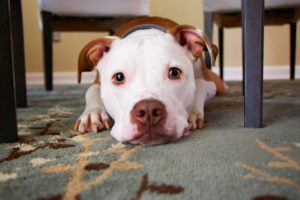May 5, 2020
We all know that our dogs are thrilled to have us home everyday. But what’s going to happen when pet parents start going back to work and the dogs are left alone again for hours at a time? Do you have anxiety thinking about separation anxiety? Here are some tips from Rover-Time to help ease the transition.
How do I know if my dog has separation anxiety?
Because we are gone when our dogs are experiencing separation anxiety, it can sometimes be hard to diagnose. Here are some signs to watch for that your dog may be having separation anxiety:
- Drooling (notice if their muzzle, paws, or the floor is unusually wet)
- Pacing
- Vocalization-do you hear a lot of barking when you leave? Has a neighbor mentioned hearing barking for a sustained length of time?
- Digging at the door
- Urinating inside (especially if they are potty-trained)
- Destructive chewing
When you get home, a dog that has been anxious might whine or become a “velcro” dog, following you from room to room, unwilling to leave your side.

What causes separation anxiety?
It’s not totally known what causes separation anxiety, but one of the causes can be when a dog gets used to constant contact with their human. Since we are now at home constantly around our dogs, this could prove challenging when we return to work.
Don’t worry! Here are some tricks to help:
- Take a hike! Leave the house without your dog at least once a day; this will help them get used to the routine and they will understand that you will be coming back for them.
- Try a calm hello and goodbye. Getting a dog really excited when you are leaving or returning may increase their anxiety.
- Practise leaving the house, shutting the door and walking a short distance away. Let the dog get used to the routine of you leaving and coming back without you being gone for a long time. This should help decrease the sound of the door being an anxiety trigger for your dog.
- Be smelly! Leave your dog some clothing that smells like you.
- Establish a phrase that you say every time you leave the house. This will let them know this is all normal.
- Leave a fun toy for them with some yummy treats inside.
Establish a routine
Dogs are creatures of habit. They don’t understand why everything has changed and their human is suddenly home all of the time. Try to keep them on a regular schedule, wake up and walk them, leave the house without them once a day, and tire them out on walks. You will thank yourself later when you are going back to work and your dog is only a little bit devastated.
You got this!
Team Rover-Time hopes that these tips and tricks can help ease anxiety for both dogs and pet parents during covid. If you could use some additional resources or help, reach out to us. We’re happy to share our list of preferred certified dog trainers with you!
Zoe Sjogerman is the North-East manager for Rover-Time and has been part of the RT team for four years. When she isn’t walking dogs she is the executive director of Avalanche Theatre and an avid book reader. She lives in the north-side of Chicago with her fiance. Although she doesn’t have a pet of her own, she loves getting to walk pups all over the Chicagoland area.

Recent Comments